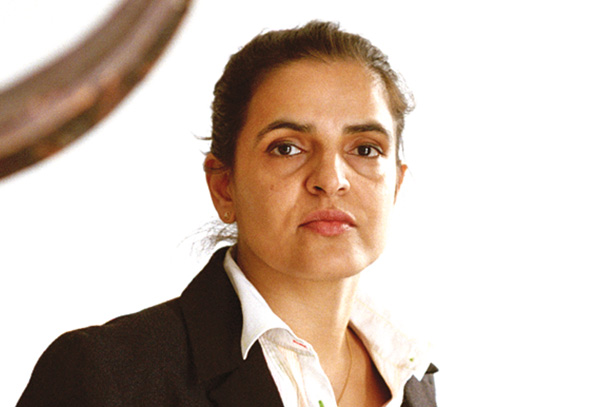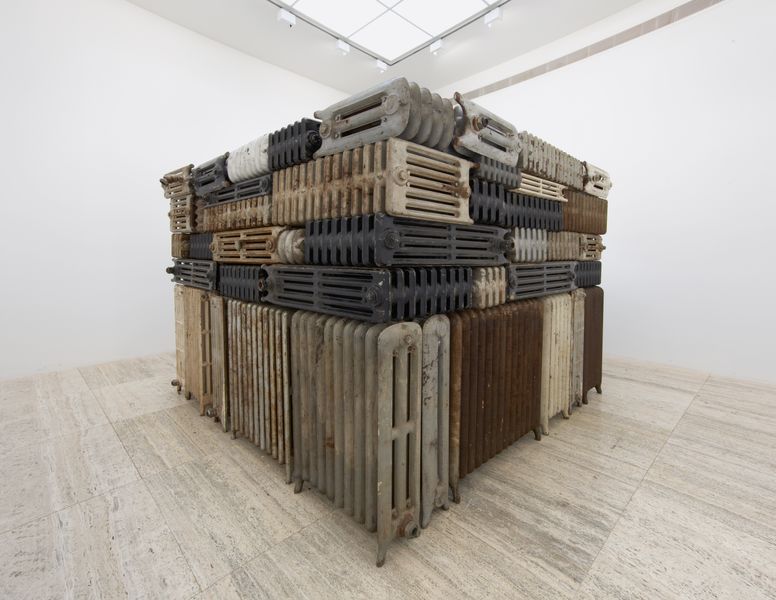Beginning March 6, 2012, Hauser & Wirth New York will present 'The hot winds that blow from the West', its first exhibition devoted to internationally admired artist Bharti Kher.
Through a group of five works, the London-born, Delhi-based artist further plumbs metaphysical questions raised by our relationship to life's quotidian activities and objects. Kher has described her practice as 'the hunt for a chimera,' a search through which she has come to see the self as a multiple open to interpretation, projection and shape-shifting. Her artmaking – including collecting and transforming found objects in a process that might best be described as fabulation – yields an air of magical realism. In 'The hot winds that blow from the West,' the artist plays with mythology, cultural and gender stereotypes, and tropes of domesticity to map a route on which viewers may travel between the familiar and the alien, the mundane and the divine, all while remaining in one place.
'The hot winds that blow from the West' will remain on view through April 14, 2012.
Responding to the intimate domestic architecture of Hauser & Wirth's East 69th Street townhouse, Bharti Kher has choreographed her works in a sequence that draws visitors through physical and psychological space. Domestic life is a persistent theme in her work, and the home front becomes a landscape where the material, the emotional and the allegorical mix. 'In Asia and India, the house and domestic space constitute a female domain and this is where women are able to truly assert more 'self' within space,' Kher has said. 'But a house is also fraught with social, economic and sexual excesses that can obscure or even threaten to obliterate the spiritual connections that are our greatest resources.' In a house, such everyday objects as the furniture and architectural elements Kher uses to construct her works, carry divine cosmic energies awaiting our engagement.
In 'The hot winds that blow from the West,' Kher introduces her themes – male and female energies in flux, transformation and alternative realities, nature and man – with a large wall-mounted work titled 'A view of the forest.'
Entering the gallery's main ground floor space, visitors will discover a massive 17 foot-long staircase. This defunct architectural fragment from an old house in India occupies the center of the room, reaching the ceiling but leading nowhere; by thwarting its purpose, Kher creates a sense of disorientation. The staircase has been splashed with red paint and covered with a swarm of black, sperm-shaped bindis, the iconic personal affect of Indian women that is one of Kher's signature materials and a loaded symbol. Since first appearing in her work in 1995, the bindi has telegraphed aesthetic and cultural duality, and a means to mix the superficial with the sublime. 'Many people believe it's a traditional symbol of marriage while others, in the West particularly, see it as a fashion accessory,' she has explained. 'But actually the bindi is meant to represent a third eye – one that forges a link between the real and the spiritual-conceptual worlds.'
In the sky lit back room of the gallery's ground floor, visitors will find the work from which the exhibition takes its title. 'The hot winds that blow from the West' is a monolith comprised of old radiators sourced by Kher in the United States over the course of six years and shipped to India. Ultimate symbols of domestic comfort in the West, these displaced appliances have been unmoored both literally and figuratively; the journey eastward has removed their purpose and altered their significance. With its rows of pipes and peeling paint, this stack of defunct tools evokes decaying animal carcasses with ribs exposed. Here, the powerfully familiar is transmuted into something otherworldly, alien and elusive.
The title of this work is a reference to The Loo, a fiercely hot, maddening and occasionally even fatal summer afternoon wind that blows across North India and Pakistan. 'We think of winds as harbingers of change, carrying voices of transformation,' Kher has said. 'From where I sit, the winds blowing nowadays from the West – from the places that were the seats of power and authority throughout the 20th century – are no longer as strong or reliable as they were. Other voices are changing the landscape now and political uncertainties have put the world in flux, feeling precarious. Traveling East, these radiators became defunct. I suppose I am sending them back to the West as messenger and, perhaps, as warnings.'
On the gallery's second floor, the exhibition continues with two works. A life-sized fiberglass figure – part woman and part animal – brandishes a pitchfork and dances on one foot. Powerful and vulnerable with exposed genitals and a monkey tail curling up over her shoulder, this apparition is described by Kher as 'an urban witch, a woman of both mythology and everyday life, a hybrid.' The sculpture is the most recent in a series of figurative works in which Kher has presented hybrid beings that conjoin contradictions of gender, species, race and role. For this work, the artist has drawn upon the attributes of the Hindu goddess Dakini, who is considered the manifestation of energy in female form. Associated with revelations, Dakini (Sanskrit for she who traverses the sky or she who moves in space) is an agent of creation and transformation – a willful instigator, messenger, and even a volatile trickster whose purpose is to push souls further towards enlightenment. Kher's figure is elegant and alien, a simultaneous celebration of and rebuke to conventional female roles.
The rest of the exhibition envelopes visitors in an installation titled 'Reveal the secrets that you seek,' presented last spring at the Centre Pompidou in Paris. A journey ends here among twenty-seven shattered, salvaged mirrors patterned with bindis that conflate two and three dimensions. Whereas Kher customarily employs dense, swirling patterns of the tiny dots, bindis in this work are fashioned for the first time into strict, structured grids of lines that imply codes of concealed information. In the larger collage of the work's broken reflections and frames, a visitor's own visage becomes part of the artist's composition. 'It is assumed that because I was raised by Indian parents in England and then moved to India myself, I am commenting upon my own displacement or my own journey,' Kher commented. 'But my motivation does not come from the usual issues of diaspora. I am always far more interested in the viewer's journey than my own. I get my ideas from you.'























